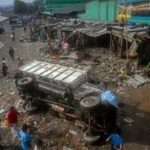Teams in Nepal’s capital are searching through destroyed homes on Monday following monsoon floods that claimed the lives of at least 200 people in the Himalayan republic.
Monsoon floods and landslides are a recurring issue in South Asia during the monsoon season from June to September, exacerbated by climate change according to experts.
Several areas in Kathmandu were submerged after experiencing the heaviest rainfall in over two decades, resulting in the capital being temporarily isolated from the rest of Nepal due to landslides blocking highways.
“Current estimates indicate that 200 people have lost their lives, 127 are injured, and 26 are still missing,” reported home ministry spokesman Rishi Ram Tiwari to AFP.
Police confirmed that at least 35 individuals were killed when a landslide buried vehicles on a highway south of Kathmandu.
Bulldozers are being used to clear around two dozen sections of major roads leading into Kathmandu which were obstructed by debris.
The home ministry is focused on rescuing individuals stranded on the highways.
Rescue teams are working to clear mud from the worst-affected riverside areas around Kathmandu, many of which are unauthorized slum settlements.
The International Centre for Integrated Mountain Development (ICIMOD) mentioned that the disaster was exacerbated by uncontrolled urban expansion near the Bagmati River in the capital.
The Nepalese army reported that over 4,000 people have been rescued using helicopters, motorboats, and rafts to transport stranded individuals to safety.
Nilkantha Pandey from CARE Nepal stated that many flood victims require access to safe drinking water and temporary shelter.
“Most of the affected are in informal settlements,” Pandey noted. “Immediate response is crucial.”
– ‘An extreme event’ –
Local merchants highlighted the severe impact of road damage on the supply of fresh produce into Kathmandu.
“Farmers have produced goods ready to transport, but due to the blocked highways, everything is stuck,” mentioned Binay Shrestha from one of the city’s main produce markets to AFP.
Nepal’s meteorological department reported record-breaking rainfall in the 24 hours leading up to Saturday morning.
A monitoring station at Kathmandu airport recorded approximately 240 millimeters (9.4 inches) of rain, the highest amount since 2002.
Climate expert Arun Bhakta Shrestha from ICIMOD suggested that rainfall should be decreasing by late September as the monsoon season concludes.
“This rainfall is abnormal,” he remarked. “It is an extreme event… Climate change may have played a role to some extent.”
He also noted that unregulated urban development exacerbated the impact of the disaster.
The summer monsoon period from July to September supplies 70-80 percent of South Asia’s yearly rainfall and is crucial for agriculture and food production in a region inhabited by around two billion people.
However, monsoon rains also bring widespread devastation in the form of floods and landslides.
Experts argue that climate change has heightened the frequency and intensity of these natural disasters.
Over 300 individuals have lost their lives in rain-related incidents in Nepal this year.
pm/gle/pbt





